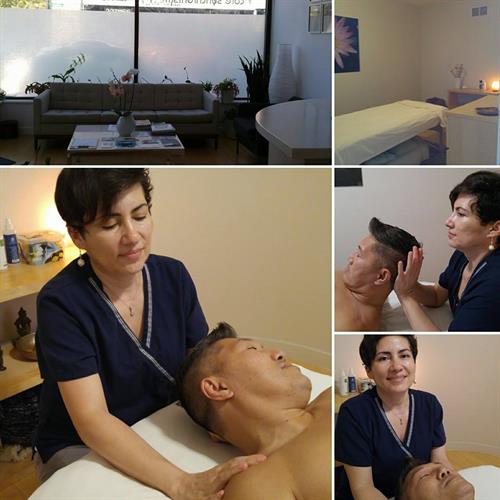 Shoulder pain is one of the most common musculoskeletal complaints. It can occur in any age group for various reasons. Most frequently the shoulder pain results from trauma and overuse of the shoulder joint and surrounding tissues.
Shoulder pain is one of the most common musculoskeletal complaints. It can occur in any age group for various reasons. Most frequently the shoulder pain results from trauma and overuse of the shoulder joint and surrounding tissues.
Poor stability + Poor mobility= Shoulder Pain
Re-establish Neuromuscular Balance by combining the benefits of two already well-established treatment protocols. Neuromuscular Therapy and NeuroKinetic Therapy™ the dynamic duo for effectively treating dysfunctional movement patterns and compensation related to muscle imbalance. It is accomplished by addressing the root cause of the problem rather than symptomatic treatment of the pain. By treating muscle imbalances associated with dysfunction and reestablish structural stability of the shoulder for mobility may prevent further damage.
What your experience can feel like:
- A sudden increase of coordination and strength in muscles that have resisted your strengthening efforts,
- A decrease and later disappearance of all your strange compensation tension,
- And the end of your aches and pain
Your muscles working properly again!
Shoulder Anatomy
Shoulder anatomy is intimately connected with human posture and movement. Posture and movement depends on neuromuscular coordination of the shoulder girdle muscles.
The rotator cuff is made up of four muscles: the supraspinatus, the infraspinatus, the teres minor, and the subscapularis. The job of this quartet is to depress the shoulder joint when performing overhead activities. The acromion is the front of the scapula or shoulder blade. It sits just above the humeral head and rotator cuff tendons. When the rotator cuff is insufficient, the acromion rubs or “impinges” on the tendons when the arm is lifted overhead, causing pain and inflammation.
The shoulder complex relies on muscles to provide dynamic stability during its large range of mobility. Proper balance of the muscles surrounding the shoulder complex is also necessary for flexibility and strength; a deficit in flexibility or strength in a contracting muscle must be compensated for by the opposite muscle, leading to dysfunction.
What are the predisposing factors of shoulder pain?
- Abnormal morphology (aberrant development of shoulder anatomy)
- Poor posture
- Overuse
- Overhead activities
- Repetitive trauma
How does poor posture create shoulder pain?
The function of shoulder joint depends not only on the integrity of rotator cuff muscles and sinews, but on the stabilization of the scapula. The ideal position of the scapula is achieved when the body is erect. Poor posture impedes scapular stability, generating excessive loads to the rotator cuff muscles.
For example: Try to lift your arm sideways after slumping your thoracic spine or protruding your chin forward and then compare the results to the range of motion of the same movement during the erect spinal position.
Your neck is a player
Muscles of the neck and shoulder region always function together, there is no movement in the upper extremity that is not reflected in the neck. In your session to treat shoulder pain we look at other factors that can be contributing to dysfunction. The site of the pain is not always the cause. So yes your neck should be considered in treating your shoulder.
What are the most common shoulder pain syndromes?
- Rotator cuff tendonitis
- Rotator cuff impingement
- Rotator cuff tears
- Subacromial bursitis
- Frozen shoulder
- Bicipital tendonitis
Helping your recovery of frozen shoulder: There are three phases to healing, during which time there are specific treatments necessary to promote faster more efficient healing to avoid chronic pain in the future.
- Inflammation phase: Addressing this inflammation is crucial to the healing process. Passive motion should be used at this point to reduce the inflammation.
- Repair Phase: Where your body attempts to replace the damaged tissue with new collagen. Nutritional supplements such as vitamin C are essential to this process.
- Remodeling Phase: New collagen needs to be properly aligned. This new collagen is irregular and in order for it to function properly, it needs a little help being “modeled” with various techniques.
You can work towards preventing frozen shoulder if you are mindful of proper stretching exercises; however, the right exercises need to be performed at the correct healing phase, or you could exacerbate the injury.
Once frozen shoulder occurs, you’ll probably be told to take an over-the-counter NSAID such as aspirin or ibuprofen. You may even be advised to undergo corticosteroid injections; however, both treatment options are temporary in nature and serve only to mask the pain and reduce inflammation temporarily.
Frozen shoulder can mean anything from no range of motion (surgery?) to reduced and painful range of motion. Often times the joint capsule is inflamed (adhesive capsulitis) and this can be resolved with treatment and rehab exercises. Bursitis is also a common shoulder problem. It is characterized by painful range of motion and pain when lying on that side. Sometimes treatment and exercise is effective and sometimes a cortisone shot is warranted. Your shoulder is also affected by poor biomechanics in tennis, golf, computer work, etc. NeuroKinetic Therapy™ corrective movement system is very effective in these cases. David Weinstock Founder of NeuroKinetic Therapy™
Pain relief is right around the corner with Mara’s perfect skill set that marries several disciplines and brings you the best of many specialties that are highly effective in restoring musculoskeletal health.
Jane found relief from frozen shoulder
 “Once or twice a year I will water ski, snow ski, or ride horses. I enjoy swimming, walking, using the Wii Fit program, and occasionally adding hand weights and time on the elliptical trainer. I do something active about 5 days a week.
“Once or twice a year I will water ski, snow ski, or ride horses. I enjoy swimming, walking, using the Wii Fit program, and occasionally adding hand weights and time on the elliptical trainer. I do something active about 5 days a week.
I had a condition called “frozen shoulder.” The pain and limited range of motion was preventing me from exercising normally and doing my daily activities. I have also had chronic neck and upper back pain.
My Chiropractor referred me to Mara and in conjunction with physical therapy and chiropractic treatment; neuromuscular therapy has helped my shoulder become practically pain-free! I have less pain, more range of motion, more awareness of what my body is doing and the stresses I put on it. I definitely recommend Mara” Jane Rainwater Texas
How often shoulder surgery is necessary for shoulder pain?
Shoulder surgery is only necessary when the conservative therapy fails or after a destructive traumatic event. Please contact your doctor.
